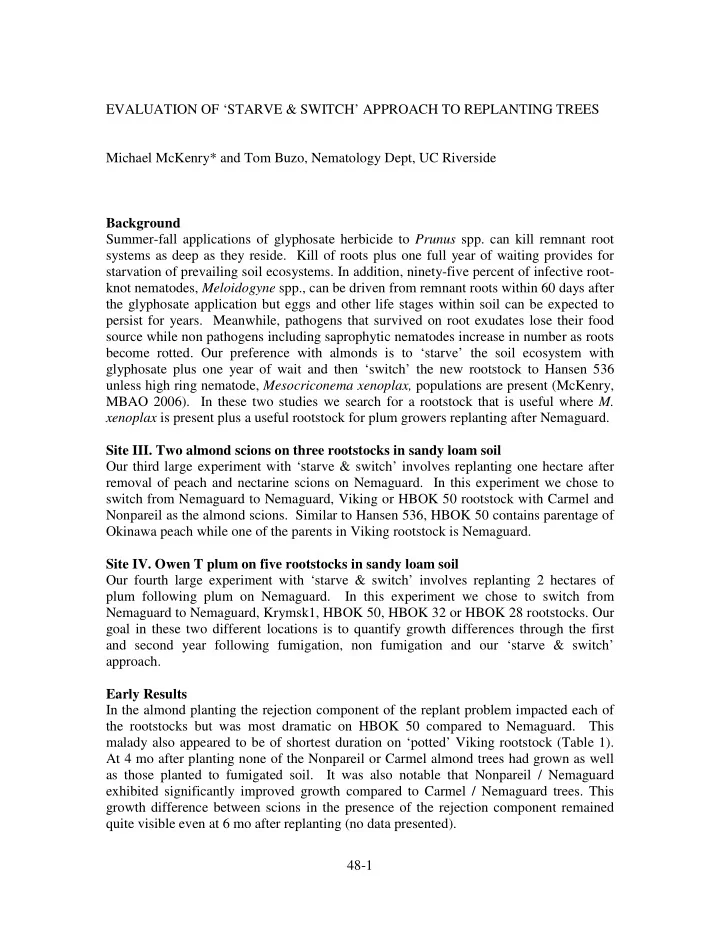

EVALUATION OF ‘STARVE & SWITCH’ APPROACH TO REPLANTING TREES Michael McKenry* and Tom Buzo, Nematology Dept, UC Riverside Background Summer-fall applications of glyphosate herbicide to Prunus spp. can kill remnant root systems as deep as they reside. Kill of roots plus one full year of waiting provides for starvation of prevailing soil ecosystems. In addition, ninety-five percent of infective root- knot nematodes, Meloidogyne spp., can be driven from remnant roots within 60 days after the glyphosate application but eggs and other life stages within soil can be expected to persist for years. Meanwhile, pathogens that survived on root exudates lose their food source while non pathogens including saprophytic nematodes increase in number as roots become rotted. Our preference with almonds is to ‘starve’ the soil ecosystem with glyphosate plus one year of wait and then ‘switch’ the new rootstock to Hansen 536 unless high ring nematode, Mesocriconema xenoplax, populations are present (McKenry, MBAO 2006). In these two studies we search for a rootstock that is useful where M. xenoplax is present plus a useful rootstock for plum growers replanting after Nemaguard. Site III. Two almond scions on three rootstocks in sandy loam soil Our third large experiment with ‘starve & switch’ involves replanting one hectare after removal of peach and nectarine scions on Nemaguard. In this experiment we chose to switch from Nemaguard to Nemaguard, Viking or HBOK 50 rootstock with Carmel and Nonpareil as the almond scions. Similar to Hansen 536, HBOK 50 contains parentage of Okinawa peach while one of the parents in Viking rootstock is Nemaguard. Site IV. Owen T plum on five rootstocks in sandy loam soil Our fourth large experiment with ‘starve & switch’ involves replanting 2 hectares of plum following plum on Nemaguard. In this experiment we chose to switch from Nemaguard to Nemaguard, Krymsk1, HBOK 50, HBOK 32 or HBOK 28 rootstocks. Our goal in these two different locations is to quantify growth differences through the first and second year following fumigation, non fumigation and our ‘starve & switch’ approach. Early Results In the almond planting the rejection component of the replant problem impacted each of the rootstocks but was most dramatic on HBOK 50 compared to Nemaguard. This malady also appeared to be of shortest duration on ‘potted’ Viking rootstock (Table 1). At 4 mo after planting none of the Nonpareil or Carmel almond trees had grown as well as those planted to fumigated soil. It was also notable that Nonpareil / Nemaguard exhibited significantly improved growth compared to Carmel / Nemaguard trees. This growth difference between scions in the presence of the rejection component remained quite visible even at 6 mo after replanting (no data presented). 48-1
In the plum replant site the rejection component appeared less prevalent as indicated by the fact that Owen T scion on Nemaguard rootstock was not significantly devigorated at 4 mo after replanting. Throughout this early data set there were no significant reductions in tree height except where Krymsk1 rootstock was replanted without soil fumigation. It was notable however that trees replanted into starve & switch settings tended to grow quite well compared to those in fumigated soil. In addition, there was a tendency for non fumigated soil to produce trees at least 14% shorter than those planted into starve & switch settings. Discussion Large field trials enable us to quantify tree growth dynamics over time as trees are first impacted by the rejection component and then eventually manage to grow beyond the problem. We are aware of no particular reason for the observed poor growth associated with Carmel scion except it has not occurred in earlier tests involving almond scions such as Nonpareil, Butte or Padre. Our plum replant site does not appear to be intensively impacted by the rejection component of the replant problem however Krymsk 1 rootstock is hypersensitive to crown gall, a known pathogen that is common across this field. One parent of Krymsk 1 is Prunus tomentosa . This parentage provides hardy resistance to Pratylenchus vulnus as well as tolerance to feeding by this nematode and Meloidogyne spp. As with many plum selections Krymsk 1 is sensitive to Mesocriconema xenoplax so we do not suggest planting it into highly porous soils such as sands and well-structured clay loams. Bullet Points When relying on rootstocks to correct replant problems, predictability of performance requires knowledge of rootstock trade-offs against various pest and disease settings. Cost associated with ‘starve & switch’ is no higher than current costs for fumigation but availability of suitable rootstocks with adequate resistance and tolerance is certainly lacking. 48-2
Table1. Early growth rates in two separate field trials Tree growth as a % of Telone fumigated at 4 mo after planting Various Soil Treatments Rootstock Telone S&S Untreated Starve & Switch III, Carmel almond tree growth after 4 mo Nemaguard 88 cm a 74% b 72% b Viking 86 cm a 77% b 77% b HBOK 50 76 cm a 70% b 70% b Starve & Switch III Nonpareil almond tree growth after 4 mo Nemaguard 91 cm a 84% b 61% c Viking 88 cm a 82% b 67% b HBOK 50 86 cm a 62% b 53% b Starve & Switch IV, Owen T plum tree growth after 4 mo Nemaguard 120 cm a 112% a 91% a Krymsk 1 99 cm a 94% a 70% b HBOK 50 54 cm a 105% a 89% a HBOK 32 124 cm a 93% a 79% a HBOK 28 52 cm a 113% a 56% a Values across each column followed by a different letter are significantly different (P=0.05) from those fumigated 48-3
Recommend
More recommend